 |
| The jovenes of the ward that I love. Fabricio, Berenice, Camila, Lissette |
Area: Fruitillares
Companion: Hermana CaseresDear familia,
This week could go down in history as the longest week in the whole world. Ayayayayaya, I am learning so many things and having so many experiences that it makes my head and heart explode. I am working way hard ... and little by little, I am seeing improvement.
First of all, this week was the week of 18! I don't know if you guys know this, but I adore being in Chile. It still blows my mind that I am in a different country and speaking a different language. It amazes me. I have grown to love Chile so much! I love the people ... I love the food ... I love the history ... I love EVERYTHING ABOUT IT!! So, this week I was walking in a little bit of heaven. There was classic Chilean music blasting from every house, the weather was perfect, we had a lot of great lessons planned ... everything was going fine.
 |
| By law, every house in Chile has to have a chilean flag outside of their house the week of 18. |
On the 18, I was super excited. All of the people we talked to asked me if I was anxious because I was bouncing around so much. The thing is, 18 is my half way point. I will probably never be in Chile to enjoy a 18 again, so I decided to live it up. We have a lot of abuelitas that we are visiting right now that are soooo sweet ... and that are bed-ridden. Basically, only these sweet ladies were going to be in their houses this day, so we had in our plans to go and visit all of them. I was so pleased to see what a difference that this made in their day. They were a little bit sad that they couldn't really participate in the celebrations, but we sang songs to them and shared the visiting teaching message with them and it totally made their day better. Oh, how I love the little old people of Chile.
 |
| The creepiest decoration that I have ever seen in my life for 18. |
Here, the ward activities for the 18 last foreeeeeever. Ours started at 3 o'clock and ended at 10 ... but in other wards, they were starting at 11 o'clock and didn't end until 11 o'clock at night. Needless to say, we only had permission to go to the activity for 1 hour ... 2 hours if we had investigators. Luckily, Carlos told us that he and Hilda were going to be able to come, so we were looking forward to spending time with the members and working to fellowship Carlos and integrate him into the rama. Unfortunately, when we passed by to visit Carlos, he was sick and couldn't come ... so we made our way over to the chapel for our hour of fun.
Once again, I was close to tears in this activity. The jovenes were dancing the cueca and I found it to be the most beautiful thing that I have seen in my life.
 |
| La cueca! |
[an example of the cueca ...]
The little kids were pulling us in every direction so that we could play with them. I felt so much love from the people of this branch. I really love them (I feel like I say that every week haha, but it is so true). We spent our hour planning fun activities with the Young Women, talking to the people, and showing our love ... and then we left. It was such a fun experience, and it made me a little bit sad to think that I won't be here in a year. Sometimes it feels like I will be here forever, but at the same time ... I know that the time is short.
 |
| Jumping rope. |
 |
| With Berenice. |
 |
| Hermana Mabel and her hija ... Mabel as well. |
 |
| Hermana Noelia Sepulveda |
 |
| Hermana Ambar (not sure her last name) |
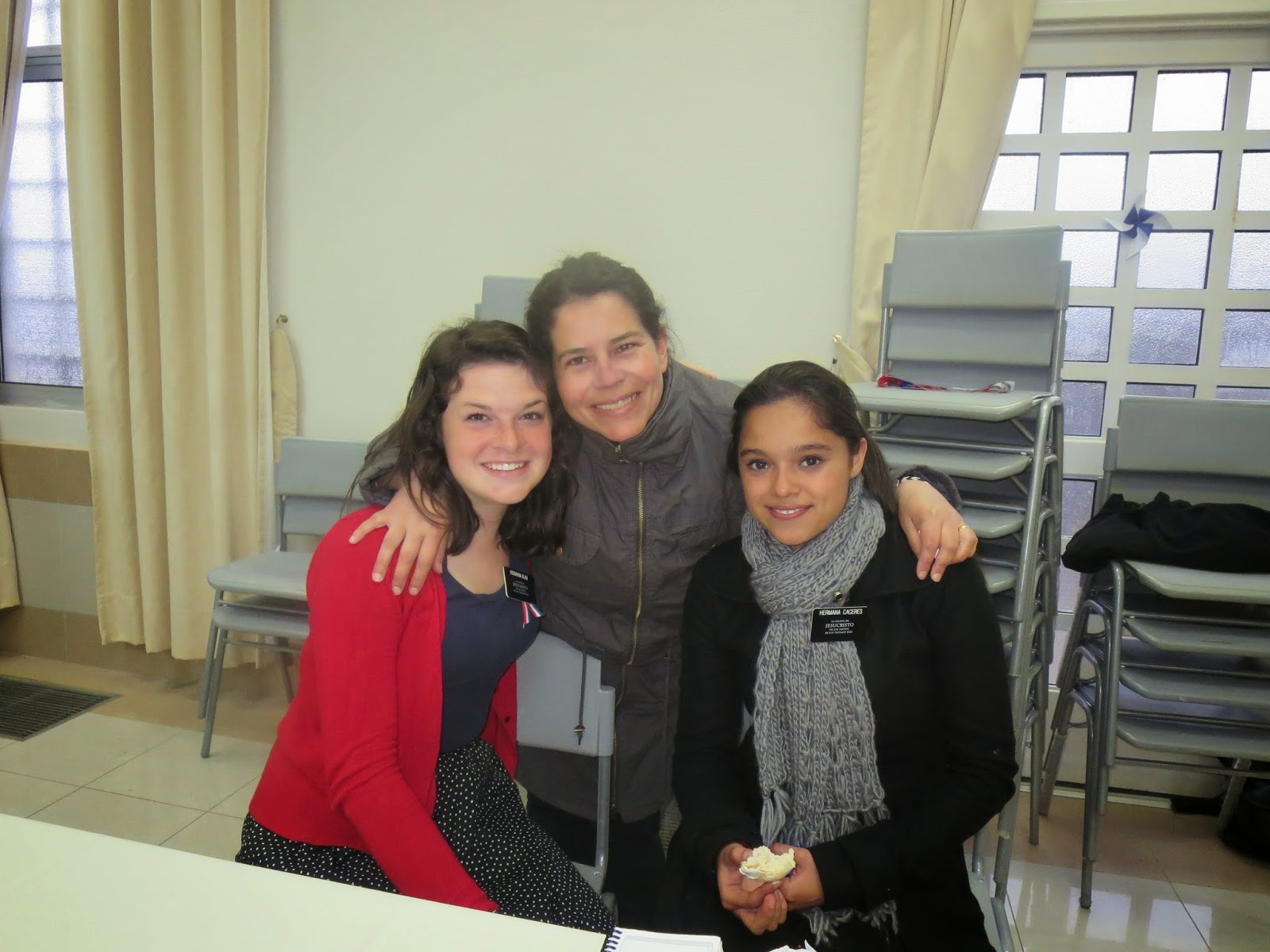 |
| Hermana Magdiel Ortiz and nosotras |
Actually, I had a little bit of a mid-mission crisis. What initiated this crisis is as follows ... The morning after the 18, we were calling our plans to see if we could go and visit them. Most of our plans cancelled because they had their families in town and didn't want our visit. We decided, "Well, Carlos has been needing a visit. We haven't had a ton of contact with him this past week. We'll call him to see if we can head on over." Because Carlos is awesome and loves the church. I started to dial his number. He answered the phone and immediately said, "Hermana, I am not going to keep listening to you guys. I am going to start working and your visits are a waste of my time." I sat in silence. He was way nice about the way he said it, but I saw all of the hope I have had in him crashing in flames. I started to cry as I hung up the phone and felt sooooo much sorrow as I explained the situation to Hermana Caceres. This is the very first time that this has happened to her on the mission and she was FRUSTRATED.
I was, too.
I went to go take a shower and the whole time I was just thinking ... What did I do wrong? What on earth could I have done better? I was trying to do everything that I knew how to do to take care of Carlos and he still chose to stop listening. Man, I had a bit of a "Lord of the Vineyard moment." I was so sad. But then, I realized something ... I have two options here. I can choose to be sad. Or I can choose to work hard and be happy. I knew that whatever option I chose would be the option that Hermana Caceres chose as well ... so I made the choice to be happy. We read the scriptures together and focused on the things that we were going to do to find new people that are going to progress. I felt some kind of fire that I always feel in the hardest moments. Something that keeps me going forward. I said to myself, "Self, there are only 9 months left to kick this mission in the tail and you are going to do it. NO MORE EXCUSES."
So, I choose to be happy. I have been waking up every day and have been promising to do my very best and I sure have been trying to do it. I remember when Hermana Harris hit a year and had 6 months left. She told me, "Every missionary has their 6 months of fire in the end of their mission when they really know what they are doing and they just go out and work." Well, I feel like I am about to experience 9 months of fire. I already know the things that I should be doing. Sometimes I don't do them because I don't know how to put the theories in practice ... but I trust that Heavenly Father is helping us.
We had a great lesson yesterday. It was totally unplanned. We were knocking a door to go to a cita that we had fixed the day before and the cita fell. I looked around at the houses that were next to this house and I thought, "Man, we have already knocked at every single one of these doors. Nobody has let us in ... so I guess we'll just keep going with our plans." I saw a little boy that was playing outside of the house where we were knocking and as a last result, I asked him if he knew if his neighbors were there. He didn't know ... I felt inspired to ask him if his mom was home ... he pointed to his baby blue house and said that she was there, so we went to knock there.
Awkwardly, we saw this lady through the window before we knocked. She opened the door and she let us in without a single question. We talked about her life and it amazed me how incredibly open she was with us. I asked her, "Why did you let us in?" She said that she saw us from the window talking to her son and said to herself, "Those are good people ... if they come to my house, I will let them in." We talked about the first lesson because she had a lot of doubts about the true church of God and if it even existed. It was such a good lesson and I feel like she really understood what we were saying. As we were getting ready to leave, she said, "And from what church are you guys from?" Hahaha. I am not sure if that was a good sign of our teachings, butchaknow ... She didn't even know that we were Mormons, but she accepted what we were teaching right away. It was a nice little wave from Heavenly Father helping us to see that miracles still do happen and there still are people that are prepared to receive us.
We had a lot of good random experiences with the people this week. A little old man let us into his house to see the Top factory that he runs (like, the tops that you play with). It was incredible to see all of the instruments that this man had innovated to make tops and sell them in bulk (what a business model!). We also were asked to give a presentation to a group of Boy Scouts later in this month. That should be pretty fun. Basically, we have been trying to use every opportunity to help people to see that we are normal people and that we are sharing what we know with the people because we love them ... and that has been opening a lot of doors for us.
Okay, now the talk about the food of this week. I think that we have already established that Chileans eat a lot more than any stomach should be able to handle. For the fiesta de la patria, this statement is even more true. I drew a little picture of my stomach in my diary that showed what was dwelling within me.
Ahhhhhhememe,
10 empanadas (the big, greasy kind)
4 cups of something called mote con huesillo (basically a dried peach that has been cooked in juices with kernels of wheat)
2 pajaritos (bread with merengue on top)
a whole cows worth of carne
1 y 1/2 servings of papas
endless servings of soda
1 cazuela
Oh my gosh, I have never felt like dying after eating ... but these past few days have been rough. Hermana Caceres still hasn't gotten the expanded stomach ... so what was worse is that I usually have to eat the stuff that she can't finish. So ... I am pretty much done with empanadas for my whole life. I am actively praying that the people will not serve it. Wow ... at least I have my health ... What a blessing!
Nine months of fire ... here I come! I am even more inspired to keep working hard. This week, we have a news conference, interviews with the president ... it is going to be a fun one. :) I love you all sooooo much! I hope that you are all happy and having a good time enjoying life!! Thank you so much for your love (even when I feel like I hardly deserve it. How did I get blessed with the best family in the world?).
A lot of love from Chile,
Laney
[In case you were interested ...]
Fiestas Patrias (Chile)
From Wikipedia, the free encyclopedia
The Fiestas Patrias of Chile consists of two days:
- September 18, in commemoration of the proclamation of the First Governing Body of 1810, and marking the beginning of the Chilean independence process.
- September 19, known as the "Day of the Glories of the Army".
Within Chile the Fiestas Patrias are often referred to as the Dieciocho, or "18th" because the celebration occurs on September 18. Unofficially, the celebration can last for around a week, depending on when it falls (for example, if the 18th is a Wednesday, celebrations extend from Saturday the 14th, through Sunday the 22nd). Most schools and jobs declare a week-long vacation for the holiday.
Activities
The celebration of Fiestas Patrias is an expression of Chilean culture. Traditional activities associated with the Dieciocho include Chilean rodeo, dancing the cueca, going to fondas, and barbecue.[1] Officially, activities on September eighteen are centered around a religious celebration "Te Deum Ecuménico de Fiestas Patrias".[2]This ceremony, which is organized by the Catholic Church and led by the Archbishop of Santiago, has taken place since 1811 when it was started by José Miguel Carrera.[2] In 1971, President Salvador Allende asked that the celebration become more ecumenical, encompassing the diverse religious beliefs throughout the country. The ceremony itself begins at 11:00am in the Plaza de Armas.[2] On September 19, a military parade takes place at Parque O'Higgins, overseen by the President of Chile.[1] Many Chileans travel during the Fiestas Patrias to visit family in other parts of the country. In Santiago, many people travel to resorts on the Pacific coast, especially Viña del Mar and the Litoral Central region. It is estimated that 2 million Chileans—nearly one-eighth of the country's population—travel during this holiday.
September 19, the anniversary of the installation of the First Government Council and the very first military parade in Chilean history, marks the grand finale: the Great Military Parade of Chile commemorating the glories of the Chilean Army, on Santiago's O'Higgins Park. Attraching millions of people, and simulcast live on radio, television and on the Internet, the parade, led by the Chilean Armed Forces (Chilean Army, Chilean Navy and Chilean Air Force) and the Carabineros de Chile, takes place in the afternoon, and marks the end of the two day holiday.
Food and fondas
Consumption of traditional Chilean foods is one of the principal displays of the Fiestas Patrias.[3] Chileans prepare these foods in their homes, or they go to fondas.[3] Fondas are venues, often tents, prepared and decorated for the Fiestas Patrias where traditional Chilean dishes and beverages are served. The largest fondas are found in Parque O'Higgins. Each year the Chilean President kicks off the Fiestas Patrias celebrations at one of these locales. For many years, the selected fonda was La Grandiosa Bertita.[3]The predominant food associated with the Fiestas Patrias are Chilean empanadas, which are a sort of bread pastry. The filling of these empanadas consist of pino, a mixture of chopped beef and onion, as well as half of a hard-boiled egg, raisins, and an olive. Many Chileans also throw a barbecue for the Fiestas Patrias. During this time sales of meat products exceed $50 million.
During the Fiestas Patrias the preferred drink is chicha, a lightly alcoholic beverage typically made from grapes, although apple chicha is popular in southern Chile. Red wine enjoys popularity during the holiday, while pisco, the so-called "national liquor", becomes secondary.[3]
Alfajores are a typical dessert. Alfajores consist of two lightly breaded cookies joined with manjar, a sweet filling made from caramelized condensed milk.
Use of the flag
In Chile, it is mandatory to hang the Chilean flag from every public building in the country for the Fiestas Patrias. The flag should be in perfect condition, hung from a white pole or from the front of every building, horizontally or vertically. If hung vertically, the star should always be in the upper left corner, visible from the front of the building. Since 1967, this has been a mandatory practice, punishable with fines in local currency of up to 40,000 pesos (about US$ 80),[4] although the law is not strictly enforced.



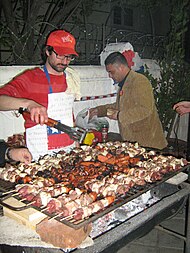

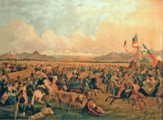
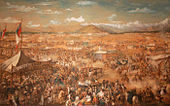

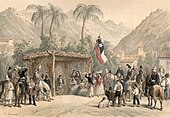
No comments:
Post a Comment